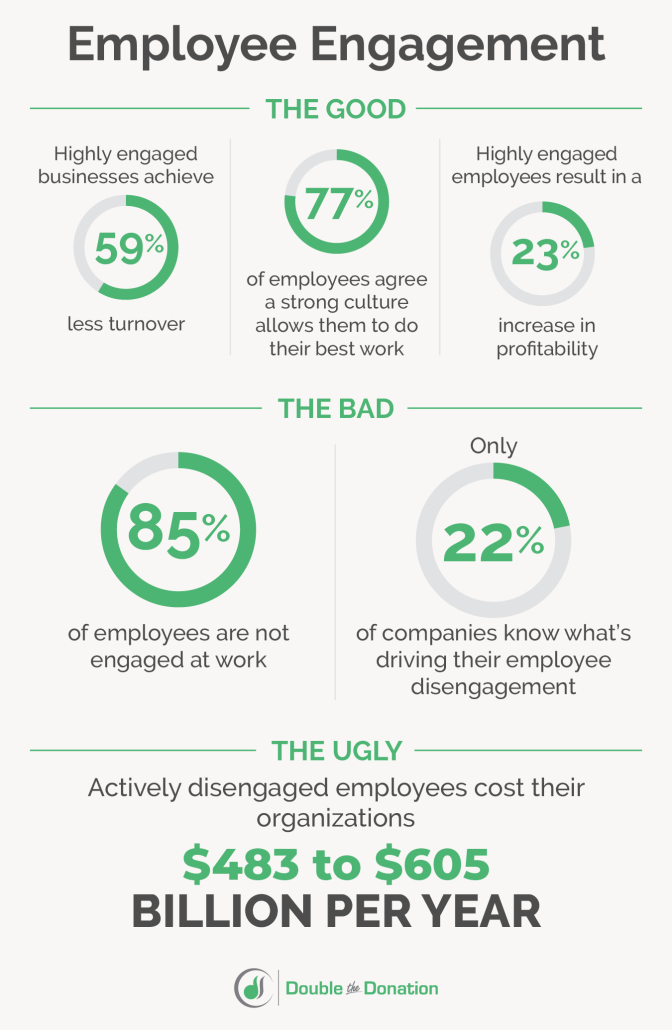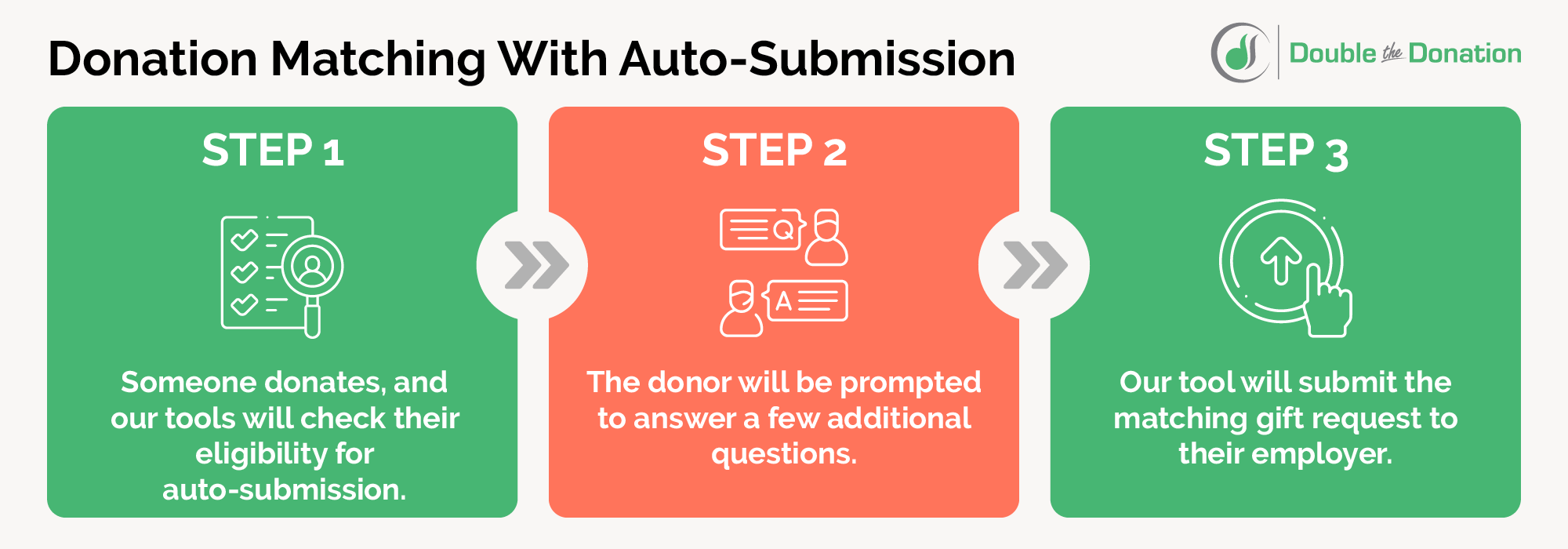From Disengaged to Inspired: A Guide to Employee Engagement
As a company, managing employee expectations and productivity can be a challenge. You want to keep them feeling satisfied and fulfilled in their work, but how exactly do you accomplish that?
In this guide, we’ll explore the key principles and strategies for sustaining employee engagement. Specifically, we’ll cover:
- The Basics of Employee Engagement
- 5 Ideas for Effective Employee Engagement
- Measuring Employee Engagement
Whether you’re starting from scratch or looking to amplify your existing employee engagement initiatives, these insights will help you create an environment where employees feel valued, motivated, and fully invested in their work.
The Basics of Employee Engagement
Before you attempt to engage your employees, ensure that you have foundational knowledge to guide your strategies.
What is employee engagement?
Employee engagement refers to the commitment that employees have to their work, team, and organization. It is a measure of how motivated employees are to go to work each day and how passionate they are about contributing to the success of the company.
Why is employee engagement important?
Recent workplace statistics prove that engaged employees are invested in their work, leading to higher levels of innovation, better customer service, and increased job performance. They are also less likely to leave your company, reducing turnover and the associated recruitment and training costs.
Take a look at these combined polls that indicate the good, the bad, and the ugly as they relate to employee engagement:
To summarize, 77% of employees believe a strong workplace culture allows them to do their best work. Companies that commit to creating a strong culture see 59% less turnover and a 23% increase in profitability.
However, an overwhelming 85% of employees admit to not being engaged at work, and only 22% of companies know what’s driving their disengagement, which can be detrimental as disengaged employees cost their organizations upwards of $605 billion dollars a year.
Who should be in charge of employee engagement?
Employee engagement is a collective responsibility that involves multiple stakeholders within an organization. While there may not be a single individual solely in charge of employee engagement, the HR department often plays a central role. HR professionals can develop programs aimed at increasing engagement—such as training, recognition, and feedback mechanisms—and monitor the success of these initiatives through surveys.
Managers also have a significant influence on employee engagement, as they directly interact with their teams and can motivate, mentor, and provide suggestions for growth opportunities. Therefore, it’s crucial for organizations to foster a shared responsibility for engagement, where everyone contributes to creating a positive and engaging workplace culture.
5 Effective Employee Engagement Ideas
Now that you have a basic understanding of what employee engagement is and why it’s important, you can begin implementing strategies to engage, retain, and empower your workforce.
1. Encourage Corporate Giving
Most people take pride in working for socially responsible organizations. If you haven’t already, create a corporate social responsibility (CSR) program that emphasizes your commitment to ethical, social, and environmental justice.
CSR activities often involve collaboration and teamwork, whether it’s choosing a charitable cause to support or volunteering as a group. These experiences can strengthen team bonds and foster a sense of community among employees, leading to improved working relationships and a more engaged workforce.
Consider kickstarting your CSR program with the following initiatives:
Matching gift programs
When employees see that you value their charitable efforts, they are more likely to take pride in being part of your organization. One of the easiest ways to support your organization’s philanthropic endeavors is through matching gifts. Under a matching gift program, you agree to match an employee’s donation with an equal or predetermined percentage of their own funds.
Traditionally, employees participating in a matching gift program have to go through a multi-step process to submit their contributions. First, they will navigate to the company’s matching gift management portal and search for the recipient organization by entering details like its name, mailing address, and tax ID number. Once the correct listing was found, they are prompted to provide information about their donation, including payment type, amount, currency, and date, and possibly upload a copy of their donation receipt.
While developing your matching gift program, your company should try to eliminate as many barriers to participation as possible. This can be accomplished through auto-submission. Auto-submission functionality is a trailblazing initiative, recently released from beta, made available through Double the Donation and its CSR platform partners—including Millie, Selflessly, POINT, and more.
When a company leverages one of these corporate giving solutions to facilitate its matching gift program, all employees have to do is provide their corporate email address (or another piece of identifying information), and the software will take care of the rest, encouraging more employees to engage in your corporate giving initiatives.
Volunteer grants
Promote community service opportunities by allowing employees to participate during work hours or providing paid time off for volunteer work. You can also encourage volunteering by offering volunteer grants, which provide funds to the nonprofits your employees volunteer at. This type of initiative not only benefits the community but also fosters teamwork among employees.
Aim for long-term, sustainable volunteer programs rather than one-time engagements. Ongoing initiatives will make a more significant impact on your community and employees.
2. Promote Professional Development
Employees are more likely to feel engaged when they see a clear path forward within your organization. Create opportunities to sharpen their skills, knowledge, and career development through:
- Training: In addition to initial onboarding and orientation, offer ongoing training programs that focus on both job-specific skills and soft skills like communication, leadership, and problem-solving. Use a mix of training methods, including in-person workshops and online courses, to accommodate various learning styles.
- Advancement: Encourage employees to create Individual Development Plans (IDPs) that outline their career goals. Managers should review IDPs with employees during one-on-one meetings and provide guidance on the skills and experience needed for advancement in different roles or departments.
- Mentorship: Implement mentorship or coaching programs where experienced employees can guide and support those looking to advance their careers. These programs can provide valuable insights and networking opportunities for employees.
- Continued education: Offer financial assistance or time off for employees pursuing additional education or certifications related to their roles. Create partnerships with educational institutions or online learning platforms to make learning resources more accessible to employees.
Professional development is an investment in your company’s human capital. Allocate the necessary resources, including budget, time, and personnel, to develop and deliver effective programs.
3. Get Creative With Recognition
Chances are your business already has employee recognition practices in place. For instance, you might offer performance bonuses, public praise, and awards like “Employee of the Month.” While these methods can be effective in engaging employees, they may feel unappreciated if recognition feels routine and uninspired.
Switching things up with an innovative solution like eCards keeps recognition fresh and exciting. Digital thank-you notes can be shared quickly through email, making them a popular choice for instant recognition.
Here’s how it works:
- Choose an eCard creation platform with employee recognition capabilities. It should also offer a variety of templates, customization options, and scheduling features.
- Select an appropriate eCard template that matches the occasion or purpose of recognition, whether it’s for a birthday, work anniversary, outstanding performance, or another event.
- Personalize the eCard by adding the recipient’s name, a heartfelt message, and any relevant images, graphics, or logos. Consider tailoring the message to highlight the specific reason for recognition, such as a recent achievement or milestone.
- Choose the delivery date and method. You can send the eCard immediately or schedule it for a future date, depending on your preferences and the timing of the recognition event.
For more information on how eCards can boost employee engagement, watch this video:
4. Promote Work-Life Balance
Promoting work-life balance is essential for engaging employees and fostering a healthier, more productive workplace. Set reasonable working hours and encourage employees to disconnect from work when they are off the clock.
Keep in mind that a culture of work-life balance should be cultivated from the top down. Leaders and managers should model this balance by respecting employees’ time and encouraging them to prioritize self-care. Encourage employees to take regular breaks and vacations, setting realistic expectations for response times to emails or work requests outside of regular hours.
By demonstrating a commitment to work-life balance and providing the necessary support, you can create an environment where employees feel engaged in their roles and fulfilled in their personal lives.
5. Foster an Inclusive Work Environment
Inclusive workplaces foster a sense of belonging among employees, regardless of their background, gender, race, sexual orientation, or other characteristics. When employees feel like they belong, they are more likely to be engaged because they are comfortable being themselves and contributing their unique perspectives.
Here are a few ways to promote a positive and inclusive workspace:
- Implement inclusive hiring practices that consider candidates from various backgrounds, experiences, and perspectives. Ensure that job postings and interview panels are free from bias.
- Establish policies that prohibit discrimination and harassment in all forms, including that based on race, gender, sexual orientation, religion, disability, and age.
- Foster a culture of open and transparent communication where employees feel comfortable expressing their thoughts, concerns, and ideas without fear of retribution.
Creating a positive and inclusive work environment is an ongoing process that requires commitment from all levels of the organization. It’s essential to continually assess and refine your efforts, seek feedback from employees, and adapt to evolving best practices in diversity and inclusion to create a thriving workplace for everyone.
Looking for even more ideas? Check out our list of 50+ employee engagement ideas!
How to Measure Employee Engagement
After launching your engagement initiatives, analyze turnover rates, absenteeism, and performance metrics to determine their effectiveness. Additionally, send out surveys and have one-on-one discussions with employees to gauge their level of commitment to your organization.
Based on their feedback, employees can be grouped into three levels:
- Engaged: Engaged employees are highly committed, enthusiastic, and invested in their work and the organization. They take pride in their roles, often go above and beyond job expectations, and are motivated to contribute to the company’s success.
- Not engaged: These employees often do the minimum required to fulfill their responsibilities and may not actively seek opportunities for improvement or growth. They can become disengaged if their needs and interests are not addressed.
- Actively disengaged: Disengaged employees are disconnected from their work and your organization. They are typically less productive and will eventually leave the organization if their concerns are not addressed.
Identify and take measures to re-engage disengaged employees to prevent further decline in morale and performance.
A Final Note About Employee Engagement
Remember, employee engagement is not a one-time initiative. It’s a continuous journey that requires commitment, dedication, and a genuine desire to create a workplace where employees feel inspired to do their best.
For more information on employee engagement, check out these additional resources:
- Why Workplace Giving Matters for Nonprofits + Companies. Looking to learn more about workplace giving programs? Check out our guide!
- A Full Guide to Employee Engagement Tools + 20 Top Picks. Ready to engage your employees? Learn which tools to leverage in this guide.
- Increase Employee Engagement With Corporate Giving. Corporate giving programs do a lot to increase employee engagement. Learn how in this guide.






